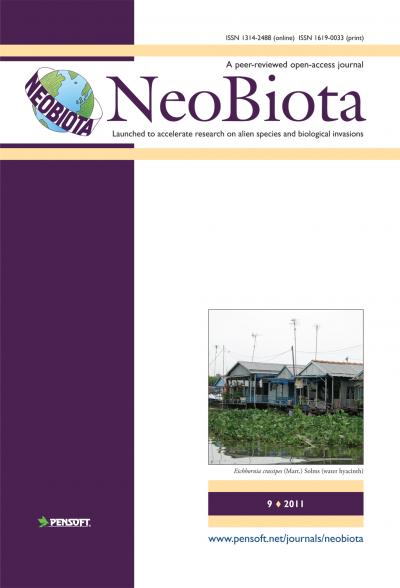Worldwide tests of generic attractants, a promising tool for early detection of non-native cerambycid species
IF 3
2区 环境科学与生态学
Q1 BIODIVERSITY CONSERVATION
引用次数: 3
Abstract
A large proportion of the insects which have invaded new regions and countries are emerging species, being found for the first time outside their native range. Being able to detect such species upon arrival at ports of entry before they establish in non-native countries is an urgent challenge. The deployment of traps baited with broad-spectrum semiochemical lures at ports-of-entry and other high-risk sites could be one such early detection tool. Rapid progress in the identification of semiochemicals for cerambycid beetles during the last 15 years has revealed that aggregation-sex pheromones and sex pheromones are often conserved at global levels for genera, tribes or subfamilies of the Cerambycidae. This possibly allows the development of generic attractants which attract multiple species simultaneously, especially when such pheromones are combined into blends. Here, we present the results of a worldwide field trial programme conducted during 2018–2021, using traps baited with a standardised 8-pheromone blend, usually complemented with plant volatiles. A total of 1308 traps were deployed at 302 sites covering simultaneously or sequentially 13 European countries, 10 Chinese provinces and some regions of the USA, Canada, Australia, Russia (Siberia) and the Caribbean (Martinique). We intended to test the following hypotheses: 1) if a species is regularly trapped in significant numbers by the blend on a continent, it increases the probability that it can be detected when it arrives in other countries/continents and 2) if the blend exerts an effective, generic attraction to multiple species, it is likely that previously unknown and unexpected species can be captured due to the high degree of conservation of pheromone structures within related taxa. A total of 78,321 longhorned beetles were trapped, representing 376 species from eight subfamilies, with 84 species captured in numbers greater than 50 individuals. Captures comprised 60 tribes, with 10 tribes including more than nine species trapped on different continents. Some invasive species were captured in both the native and invaded continents. This demonstrates the potential of multipheromone lures as effective tools for the detection of ‘unexpected’ cerambycid invaders, accidentally translocated outside their native ranges. Adding new pheromones with analogous well-conserved motifs is discussed, as well as the limitations of using such blends, especially for some cerambycid taxa which may be more attracted by the trap colour or other characteristics rather than to the chemical blend.Worldwide一般引诱剂的测试,是非本地天牛种早期检测的有前途的工具
入侵新地区和新国家的昆虫中,很大一部分是新兴物种,这是首次在其原生范围之外发现。在这些物种在非本土国家定居之前,能够在抵达入境口岸时发现它们是一项紧迫的挑战。在入境口岸和其他高风险地点部署以广谱信息化学诱饵为诱饵的陷阱可能是一种早期检测工具。在过去的15年里,神经虫信息化学物质鉴定的快速进展表明,神经虫科的属、部落或亚科的聚集性性信息素和性信息素通常在全球范围内得到保护。这可能允许开发同时吸引多个物种的通用引诱剂,尤其是当这些信息素结合成混合物时。在这里,我们展示了2018-2021年期间进行的一项全球实地试验计划的结果,该计划使用了标准化的8-信息素混合物引诱的陷阱,通常辅以植物挥发物。共在302个地点部署了1308个陷阱,同时或依次覆盖13个欧洲国家、10个中国省份以及美国、加拿大、澳大利亚、俄罗斯(西伯利亚)和加勒比海(马提尼克)的一些地区。我们打算检验以下假设:1)如果一个物种经常被一个大陆上的混合物大量捕获,那么当它到达其他国家/大陆时,就会增加被检测到的概率;2)如果混合物对多个物种产生有效的、通用的吸引力,由于相关分类群中信息素结构的高度保守性,可能会捕获以前未知和意外的物种。共有78321只长角甲虫被捕获,代表了八个亚科的376种,其中84种被捕获,数量超过50只。捕获者包括60个部落,其中10个部落,包括9个以上被困在不同大陆的物种。一些入侵物种在本土和入侵大陆都被捕获。这证明了多Heromone诱饵作为检测“意外”神经酰胺入侵者的有效工具的潜力,这些入侵者意外转移到了它们的原生范围之外。讨论了添加具有类似的保守基序的新信息素,以及使用这种混合物的局限性,特别是对于一些可能更受陷阱颜色或其他特征而不是化学混合物吸引的神经酰胺类。
本文章由计算机程序翻译,如有差异,请以英文原文为准。
求助全文
约1分钟内获得全文
求助全文
来源期刊

Neobiota
Agricultural and Biological Sciences-Ecology, Evolution, Behavior and Systematics
CiteScore
8.10
自引率
7.80%
发文量
0
审稿时长
6 weeks
期刊介绍:
NeoBiota is a peer-reviewed, open-access, rapid online journal launched to accelerate research on alien species and biological invasions: aquatic and terrestrial, animals, plants, fungi and micro-organisms.
The journal NeoBiota is a continuation of the former NEOBIOTA publication series; for volumes 1-8 see http://www.oekosys.tu-berlin.de/menue/neobiota
All articles are published immediately upon editorial approval. All published papers can be freely copied, downloaded, printed and distributed at no charge for the reader. Authors are thus encouraged to post the pdf files of published papers on their homepages or elsewhere to expedite distribution. There is no charge for color.
 求助内容:
求助内容: 应助结果提醒方式:
应助结果提醒方式:


